Energy 101: A Rational Approach Towards Our Energy Future
J. A. Pacht - 12 Jul 2021
Introduction .
How much energy, in watt-hours, does every man, woman and child in the U.S. use in a year? This is probably not a question you’ve thought about. So, let’s think about it! You can use the LED light bulb above your head as a guide. It likely consumes seven watts per hour. What is your answer? 100,000, 1,000,000, 10,000,000? If your answer was any of these numbers, you are wrong. Every man, woman and child in the United States uses over 100,000,000 watt-hours of energy every year. Don’t feel bad if you didn’t get the answer correct. I have posed this question to numerous energy professionals over the past two years, and few get it right.
So why is the number so big? Energy is in everything we do. For example, food for a family of four for a week takes the energy equivalent of 22 gallons of gasoline to grow, transport, and sell. A single pair of blue jeans takes the energy equivalent of three gallons of gas to create the raw materials, manufacture, transport, sell, and wash (Tinker, 2012). When we think about energy, we might think about filling up our cars with gasoline. But we don’t think about how much energy was used to build the car or build and maintain the roads we drive it on. If energy is in everything we do, then the COST of energy is in everything we do. Most decisions made regarding energy worldwide are made based on cost. Increases in the cost of energy affect every part of the economy and those increases hit the poor the hardest.
When we talk about energy, we must talk about what Tinker (2019) calls “The Three E’s”. These are energy, the environment, and the economy. The E’s are inextricably linked (Fig. 1). We cannot modify one “E”, without affecting the other two.

Most of the discussion regarding energy, the first “E”, focuses on fossil fuel sources vs. wind and solar. But nuclear will have an important role to play in our energy future. Discussion regarding the environment, the second “E” has focused on CO2. However, we also need to talk about land use, habitat reduction and the effects of mining in ecologically fragile areas. Finally, we come to the economy, the third and most important “E”. Energy poverty is a huge problem, not only worldwide but even in developed countries such as the U.S. In the United States, 20 percent of our population has had to choose between energy, and food or medicine (EIA, 2018; NPR, 2018). Most countries will not compromise their economies to reduce carbon emissions. Our decision to do so will increase energy poverty in the United States.
The effect of the shale boom on the economy of the U.S has been nothing short of spectacular. From June 2009 to June 2019, the net fixed investment in oil and gas extraction represented more than two-thirds of total U.S. industrial development and accounted for 40 percent of the growth in U.S industrial production. It has resulted in the creation of 2.8 million jobs and will result in approximately 1.6 trillion dollars in Federal and state revenue from 2012 to 2025 (Yergin, 2021). But we live in a competitive world. If we walk away from those gains and elect to increase the price of energy by moving to more expensive renewables, we damage our economy. We decrease our ability to compete with countries such as China and India that intend to continue to burn coal. We cannot talk about energy as if it is the only “E”. Neither can we talk about the environment as if it is the only “E”. We must deal with all three of them.
Energy Types .
Today the world runs on fossil fuels. As of 2019, 89% of the world’s energy came from fossil fuels. Only 4.5% came from renewables (Fig. 2). To understand energy, we must first ask ourselves: “What does an energy source need to be? There is no perfect energy source. We need to understand how different energy sources are used and the advantages and disadvantages of different energy sources.
-
An energy source needs to be affordable. Energy that is not affordable is not sustainable. Government subsidies can make an energy source appear more affordable, but they cannot be sustained forever.
-
An energy source needs to be available. Fossil fuel sources are easily transportable. Other sources have greater challenges.
-
An energy source needs to be reliable. Solar and wind are intermittent sources of energy. The sun does not always shine, and the wind does not always blow. Grid storage batteries deplete in approximately four hours and can only address short-term fluctuations. Large batteries are also expensive and the costs for those batteries will be passed on to consumer.
-
All energy sources affect the environment in some way. This includes, but is not limited to, CO2. (Tinker 2012).
With these factors in mind, we can look at the various energy sources we currently use.

Transportation - Oil
Oil is dominantly used as a transportation fuel. We use it because it works. Figure 3 shows the energy density of various types of transportation fuels. Batteries are very heavy relative to the amount of energy that they produce. Combustible gases are light but produce small amounts of energy per unit volume. Gasoline and diesel are in the “sweet spot”. A single gallon of gasoline can transport four people in comfort for 58 miles at 60 mph (Toyota Prius Specifications, 2021)

Today there is a strong push to transition from internal combustion (IC) engines to electric cars. Some states in the US and countries are limiting future sales of cars powered by IC engines. What are the effects of this going to be? Many who live in single-family dwellings and who only use a car for commuting will adjust quite easily. A Tesla Model 3 can be fully charged in six to thirty hours using a 220v outlet. The variations are dependent on the amount of amperage. However, it takes four days to fully charge the same Tesla Model 3 using 110v power. This makes recharging at home challenging for those who live in apartments and who may have to park several hundred feet away from their apartment doors. It is simply not practical to run a several hundred-foot extension cord from their apartments to their cars for a period of days. Commercial superchargers are few and far between in many states and countries and they take around 45 minutes to fully recharge an electric car. If there are cars ahead of you it is going to be a long wait.
Electricity
All the other sources of energy I discuss are used largely to generate electricity. Electricity is unique. It is the only commodity that is consumed the moment it is created. Today most of the energy used for electricity in the world comes from fossil fuels. 38.2% comes from coal and 23.2% comes from natural gas. Renewables make up 8.4% and solar is less than 2% (Fig. 4)
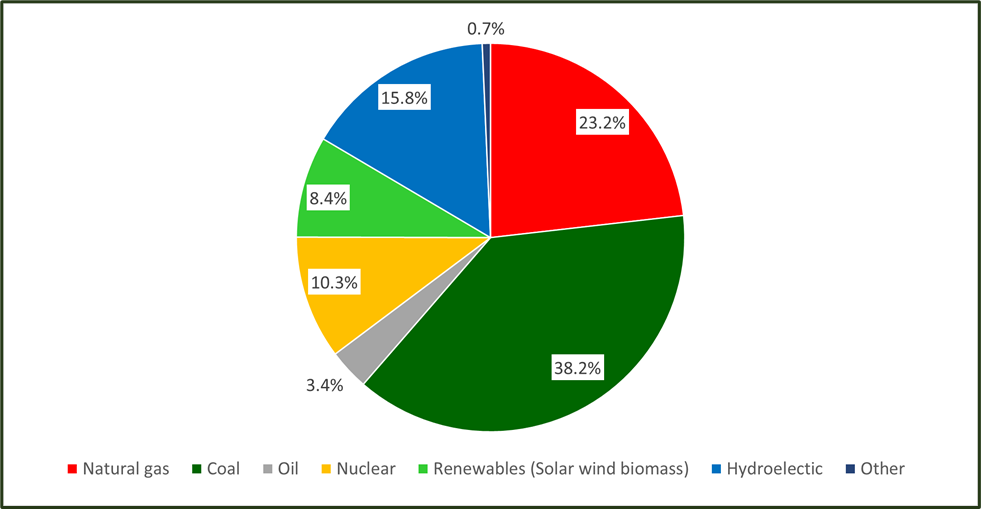
Let’s look at the pros and cons of each of these sources:
Coal
Coal is available, affordable, and reliable. It is the most abundant and cheapest energy source in the world and is the easiest to mine and process. Therefore, coal is the dominant energy choice of developing countries and Asia. The amount of coal consumed for energy has increased over 5X in Asia during the past 30 years. In fact, over 50% of the coal used for electricity is consumed in China. China currently has 993 giga watt-hours (GwH) of coal power capacity and is currently building over 300 new coal plants which will generate an additional 259 GwH (BBC, 2018). The U.S. currently has 244 GwH of coal fired capacity, down from 317 GwH in 2011. Europe also shows decreasing use of coal. Coal produces 2.08 pounds of CO2 per KwH, making it a major contributor to greenhouse gases.
Natural Gas
Natural gas is also abundant, affordable, and reliable. The United States has a network of pipelines to easily transport it from the well to the consumer. Natural gas is also relatively clean. It emits 58% of the CO2 that coal emits (1.12 pounds CO2 per kilo watt-hour (KwH)). There has been much discussion in the press about methane emissions, but methane is only resident in the atmosphere for 10-12 years. In addition, methane emissions have decreased by 24% as gas production has increased by 19% and oil production by 65% from 2011 to 2017 (EIA 2018, EPA, 2018). Methane is a more powerful greenhouse gas than CO2, but the volumes released by anthropogenic processes are very small relative to CO2. Therefore, its impact on global warming is minimal relative to CO2. The U.S has greatly reduced its own CO2 emissions by switching from coal to gas. Conversion of coal-fired power plants to natural gas-fired plants has led to a 14% reduction in CO2 emissions since 2005 in the U.S. (EIA, 2020). New technologies are also being developed to sequester CO2 emitted from natural gas power plants in a cost-efficient manner.
Nuclear Power
Nuclear power is available, affordable, reliable, and clean. Nuclear has it all. There is zero pollution of any sort. France gets 75.6% of their electricity from nuclear power and it is the largest electricity exporter in the world. They have solved the storage problem and they recycle 96% of fissionable material. France will be the first major country to produce all their electricity without using any fossil fuels. As of 2017, only 5.6% of their electricity was derived from coal and natural gas (Fig. 5).
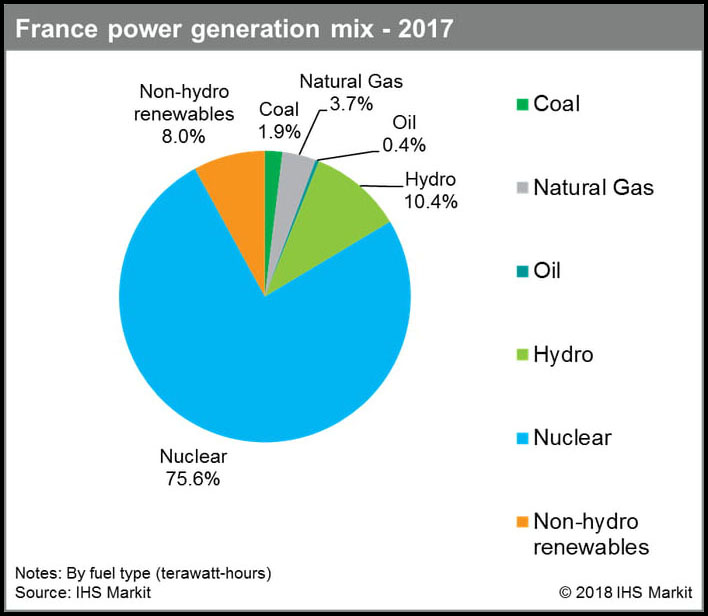
Sadly, it has been politically very difficult to build new nuclear plants in the United States. Punitive regulations have made it very difficult to build reactors that can supply electricity at a reasonable rate. Two plants have recently added reactors and one small new plant is working its way through the process. However, many reactors are reaching the end of their service life and are being shut down. The average age of nuclear power plants in the U.S. is over 40 years. Many plants are being decommissioned and the energy created by nuclear reactors in the U.S. has declined. Reactors in France are newer, safer, and far better. We are also beginning to see major new innovations in reactor design. These include small modular reactors and thorium reactors.
Biomass
Biomass is the dirtiest fuel available. It puts 9% more CO2 into the atmosphere than coal along with other many other pollutants. It is a major cause of respiratory diseases in the undeveloped world, where it is commonly used for cooking. Biomass is sold as “green fuel” using highly flawed logic. We are told that a tree absorbs CO2 during its lifetime so when it is burned the there is no net CO2 added to the atmosphere. What no one asks is: What if the tree is not burned? When plants decay naturally much of the carbon is not oxidized and turned to CO2. Instead, it is reabsorbed into the ecosystem due to consumption by organisms such as bacteria, insects and fungus. Good soil is filled with organic material derived from decay of older plants. Carbon is also stored in wood that is harvested and used to build homes and furniture.
Hydro Power
Hydro power is great where you can have it. It is clean, affordable, and reliable. However, you need proximity to large rivers with steep gradients and lots of rain. The state of Oregon, for example, has these assets and gets 43% of its electricity from hydro power. However, many areas in the world do not have the proper topography or climate. In addition, dams may interfere with commerce and cause environmental damage.
Wind and Solar
Wind and solar both have the same advantages and the same disadvantages. They are both clean energy sources. But they are more expensive that other sources, even with today’s government subsidies. Both are intermittent energy sources. Wind power only works when the wind blows. Solar power only works when the sun shines. Therefore, they are not reliable. Wind and solar are also both “low density” energy sources, so centralized solar plants and wind farms require a large footprint. They require low value real estate in remote areas. Finally, a massive infrastructure investment in high tension lines and power substations is necessary to get power from these plants to population centers.
Wind and Solar Footprint
How much real estate do these energy sources require? Using the Ivanpah Solar plant in the Mojave Desert as a guide, I calculated how big a solar facility would have to be to power Greater Houston. The Ivanpah Solar Plant is 3,600 acres in size and supplies electricity to 140,000 households. Greater Houston has 2,324,758 households and a lesser amount of solar radiation. The solar radiation at Ivanpah is 7.4 kW h/m day. In Houston, it averages 4.5 kW h/m day. I also had to consider the fact that residential use of electricity is only 38% of total use. Therefore, a centralized solar plant big enough to power Houston would have to be 257,996 acres or 403.12 sq. miles in size. That is nearly the size of Houston itself (Fig. 6).

Wind requires even more acreage. The Buffalo Gap Wind Farm is one of the largest wind farms in Texas. It has a nameplate capacity of 523.3 mega watts (MW). However, that number is misleading as nameplate capacity is only reached when all turbines are operating at maximum efficiency. The average electrical output is 33.3% of that (174.3 MW). The Buffalo Gap Wind Farm provides electricity for 175,422 households at maximum capacity but on average it can only supply electricity to 58,415 households. Wind intermittency also creates issues in Texas. Wind power generation generally decreases during late summer in Texas when demand in Texas is highest. Spot energy prices in Texas spiked from $20 -$30 MwH to over $9,000 MwH in the August 2019 during a major heat wave. There was worry about a similar problem in June 2021. Wind velocity was low and electricity demand was very high.

Wind turbines have also created issues for those who live nearby them. WHO has documented negative health effects for humans living near wind farms due to low frequency noise. Local communities are strongly protesting the installation of nearby wind turbines. Since 2015, about 300 government entities from Vermont to Hawaii have rejected or restricted wind projects. In California, wind turbines are so difficult to site that most developers have simply given up trying to build new projects in the state. New York State passed legislation to force local communities to accept wind projects against their will (Bryce 2021; Dugstad et al., 2020). That legislation is almost certainly headed to court.
Scientific research shows that wild herbivorous animals avoid windfarms. Hundreds of thousands of birds and bats are killed each year by wind turbines (Lopucki et al 2017). But the biggest issue is the acreage required for a wind farm. The Buffalo Gap wind farm covers 69,120 acres (108 square miles). That means that to power a single household requires over one acre of land dedicated to supplying the power (Fig. 7).
Rooftop Solar
It is not necessary to use the grid to power or partially power a household with solar. Many have elected to put solar panels on their homes. So, I calculated how much it would cost to get 50% of my yearly power from solar energy. There are multiple websites to help you calculate this. The two I used were: Energy Sage Solar Calculator and WholeSolar Calculator. The answer for me was approximately $45,500. The government will give me a check for $10,500, reducing my total yearly expenditure to $35,000. But is that cheaper than getting power from the grid? The answer is: It depends on where you live. I pay $0.097/KwH, which is an average rate for Texas. My average bill is $325/mo. Solar panels last for approximately 20 years. So, I calculated the monthly payment on a 20 year note for $35,000 with 5% interest. My monthly payment on that loan would be $230.98. Since that only covers 50% of my electricity, my average electricity bill would be that $230.98 + $162.50 or $393.43. That would be $68.43 more than I pay now. I did not include yearly maintenance, which would add $600-$1000 per year.
If I lived in Massachusetts, my answer would be different. Instead of paying $0.097/KwH I would be paying $0.226/KwH. Massachusetts has some of the highest electricity rates in the continental U.S due to regulations, prohibition against building pipelines, and a move toward renewable sources. Instead of getting natural gas from the nearby Marcellus gas fields in Pennsylvania, they import liquified natural gas (LNG) from Yemen and Russia, among other countries. That greatly increases the cost of electricity. In Massachusetts, my average bill from the power company would be $649.52/month. By switching to 50% solar I would save $85.78 per month.
The state government of Massachusetts has taken measures against fossil fuel use that have made electricity 2.3 times more expensive than in nearby Pennsylvania, where rates are similar to those in Texas. Are these rate increases to reduce global warming supported by the public? In 2018, Yale researchers asked that question. They asked how much more people were willing to pay to get their energy from 100% clean, renewable sources. They interviewed 48% Democrats 36% Republicans and 16% independents (Fig. 7). Although Democrats were more willing to pay higher prices the numbers are quite conclusive. 47% of all surveyed stated that they we not willing to any more money at all. Only 14% were willing to pay more than $31.00 extra per month (Fig. 8). Those in Massachusetts are currently paying far more than that relative to those in nearby Pennsylvania. These price differentials affect the poor the hardest. It is, therefore, fair to ask if state legislators in Massachusetts are truly looking after the interests of their constituents.
Another question needs to be asked: I am an affluent person who has had a very successful career. I do not need the $10,500 that the government is willing to give me to put solar panels on my home. Should our government be taking money from hard-working middle-class and lower middle-class taxpayers and giving it to those who do not need it? Is it moral for our government to do so?
Are wind and solar scalable?
Our nation, along with many European nations are currently embarking on a hugely expensive program to move from fossil fuel sources of energy to wind and solar. But few have asked if this is even possible. Will our economic rivals, like China, commit to a similar program? What are the implications for our economy and our environment if they do not and instead continue to use cheaper high-carbon sources? Today, increases in wind and solar do not make up for global growth in energy consumption. In the oil and gas business you will hear people talk about the “Creaming Curve” It refers to “skimming the cream” meaning that we drill wells in the best areas first. We have done the same for wind and solar. We built solar plants in the Mojave Desert and wind farms in flat, windy, lightly-populated areas in Texas. Additional locations will be suboptimal and therefore more expensive.
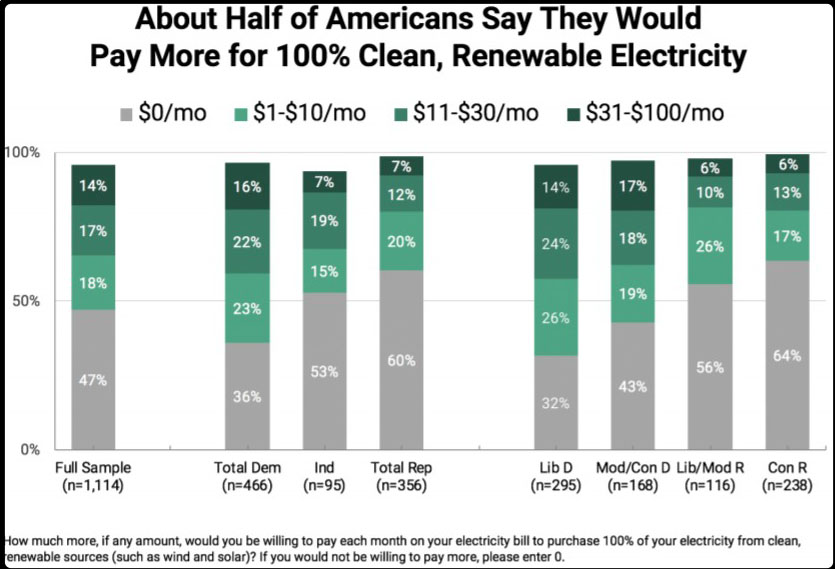
The most important variable that controls our ability to switch from fossil fuels to renewables will likely be the availability of the metals necessary to make this switch. The IEA (2021) stated that to meet world climate goals we must increase lithium use by 40X and graphite, copper, and nickel by 20X- 25X. Where are these metals going to come from? No one knows. It is not clear that some of these metals even exist in sufficient quantities. Today they come largely from China. Figure 9 shows who controls extraction and processing of these minerals. China also controls 80% of the solar photovoltaic cell market.
Over 50% of the cobalt (an essential component of Li-Ion batteries), comes from a single province in the Congo. All the photovoltaic systems currently on the market are reliant on one or more raw materials classed as critical or near critical by the EU or the US Department of Energy because of their natural scarcity or their recovery as minor-by-products of other commodities. They include high purity silicon, indium, tellurium, and gallium. What happens to the cost of energy if the cost of these metals skyrocket, either due to natural scarcity or market manipulation by China? We saw the perils of overreliance on critical goods from China with the Covid-19 pandemic. Do we as a country want to be reliant on China for our energy?
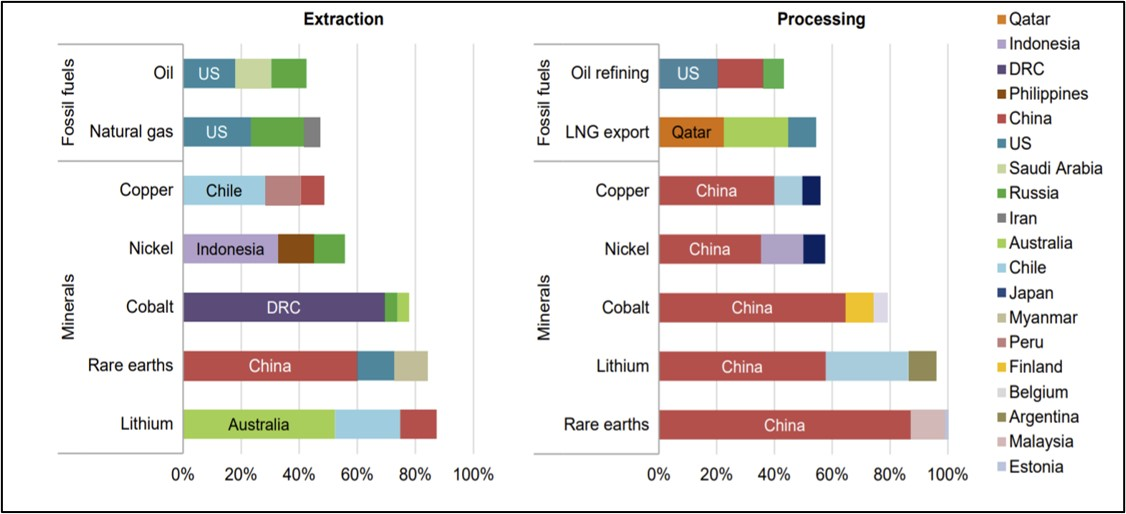
Batteries
There has been quite a bit of talk about battery technology in recent years and how this technology will solve the reliability problems for wind and solar. However, reality is a bit more sobering. Grid storage batteries deplete in around four hours. To store the electricity the U.S. uses in one day would take the entire output of the Tesla Gigafactory for 500 years (Mills, 2020). In addition, it costs $15-$18 per barrel to purchase an oil storage tank. To store an amount of electricity equal to the energy in one barrel of oil (1,700 kWh), it would cost $510,000 based on the $300 per kWh cost of the Tesla Megapack (JP Morgan, 2021).
In 2019, Herrington did a study in which he observed that to convert all the cars in the UK to electricity by 2050 would require the entire world’s production of neodymium, three quarters of the world’s lithium production, and at least half of the world’s cobalt production. I took his figures and extrapolated them to the U.S. To convert all our cars would require 1.7X the world cobalt production, 3.4X the world neodymium production and 2.6X global lithium production. And even if we converted every IC car in the world to electricity, global CO2 would only drop by around 5% (Yergin, 2021). The electricity to charge these cars still must come from somewhere and that somewhere will be fossil fuels. To produce a single car battery 250 tons of earth needs to be mined, refined, processed, and shipped (Mills, 2020). Mills (oral comm., 2021) also noted that far more energy is used in the construction of car batteries and in mining, processing and extraction of the raw materials than in building the car itself. All of that creates environmental damage. Figure 10 shows a lithium mine in Western Australia. An oil pumpjack has been added to the picture for scale. Which one do you believe creates more environmental disruption?
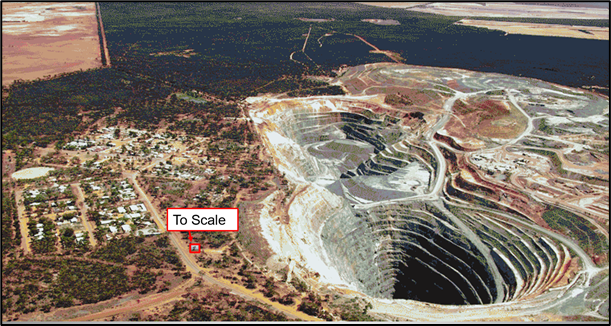
The Brave New World .
Today, the U.S. controls its own energy. We are the largest producer of oil in the world. We have enough natural gas to last several hundred years. We have been the beneficiaries of cheap energy for our entire lives. But we are making the decision to make our energy more expensive and more reliant on foreign sources by moving to renewables. What are the immediate effects of this? The answer is that we subsidize China, not only by buying their strategic metals but also by making our products more expensive as a function of using more expensive energy. U.S. produces ~13% of global CO2 emissions. These emissions have been flat since 1980 and decreased by 14% since 2005. Worldwide, however, CO2 emissions have increased by 23% since 2005. Most of that increase is from China, which produces 29% of world emissions, and India (Fig. 11). China’s 300+ new coal plants alone will produce more CO2 than all the coal plants currently in operation in the United States.
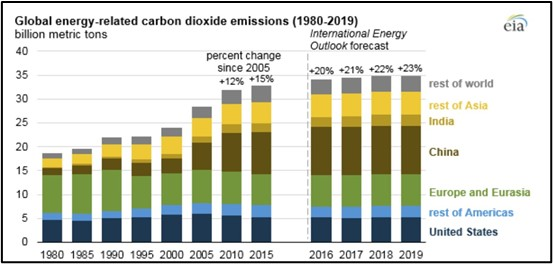
China imports around 75% of its oil. However, they have vast reserves of coal. Therefore, they see coal as a strategic resource, and they have made it very clear that they do not intend to reduce coal usage anytime soon (Yergin, 2021). During the past 20 years, India has gone from around 33% household electrification to almost 100%. As a result, their per capita GDP has tripled during that same period. They have done this by using coal-fired power plants. The Prime Minister of India, Narendra Modi, has made it very clear that the economy of his country comes first and stated: “we are too poor” to move to renewable sources. EIA predicts a 50% increase in global energy use by 2050. Nearly all that increase will be in Asia (Fig. 12) and much of it will be derived from coal.
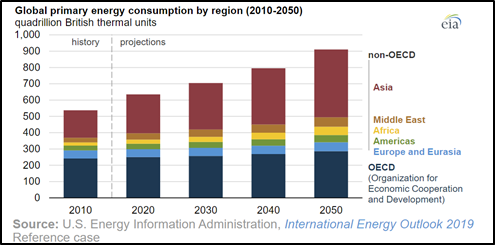
So, what exactly must happen in order for the world to go to 98% carbon free by 2040 as many American and European policymakers want to happen? Tinker, 2019, illustrated this with a series of figures. Figure 13 shows where we are at now. It shows our current energy mix. Note that you cannot even see solar on this chart.

Tinker (2019) then superimposed the energy usage chart on another chart which shows population growth (Fig. 14a). As world population grows, energy usage will obviously increase. His final chart Figure 14b, shows what is necessary to accomplish to get to 98% carbon free energy by 2040. Does this look realistic to anyone?
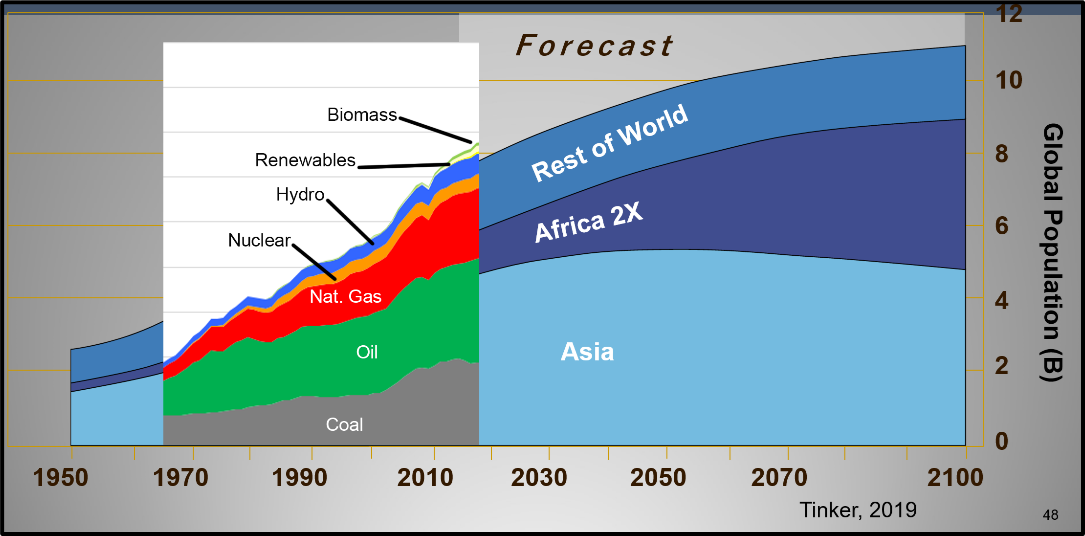

Inconvenient Truths .
This whole discussion started with an “Inconvenient Truth”. So, let’s list a few more.
-
It is not technically possible to move to 100% carbon-free energy production in the near future.
-
It is not politically possible to move to 100% carbon-free energy production in the near future.
-
It is not economically possible to move to 100% carbon-free energy production in the near future.
It is inhumane to move to 100% carbon-free energy in countries affected by energy poverty. Many developing countries cannot afford renewables. They need to get out of energy poverty first.
-
China and India will continue to increase CO2 emissions no matter what we do.
-
Global energy consumption will rise by 50% by 2050.
Many in Europe and the United States think that if they, as countries act, the problem will be solved. Other countries will follow suit. But both China and India have made it clear that they are not going to do so. Coal-fired power plants have a 60 to 100-year life. China is not building 300+ of them today to discard them tomorrow. They will, however, be glad to sell us PV cells manufactured using coal. It is not anthropogenic United States warming and it is not anthropogenic European warming. It is anthropogenic global warming. China and India will be growing, not reducing their own carbon footprints over the next 50 years and we are not going to go to war with China over coal usage.
So, what can we do? Scott Tinker made several suggestions in 2012 that are still relevant today. He mentioned that renewables (solar, wind, hydro etc.) are increasing but they cannot increase to a level where a crossover between fossil fuels and renewables occurs in the next 50 years. That crossover can only occur by increasing use of the transitional fuels: nuclear and natural gas along with renewables. Tinker observed that this will require that we double natural gas production, increase nuclear energy by 3X and increase renewables by 5X. We are meeting those goals with natural gas and renewable. However, the United States and other European countries are shutting down nuclear power plants. According to Dan Crenshaw (U.S. Representative):
“If you are not serious about nuclear power, you are not serious about climate change.”
Transitioning to nuclear power is the best way by far for developed countries to make a material difference in their CO2 emissions.
We can also work on carbon capture. Today a 50 MW natural gas plant is operating in Laporte Texas that has zero CO2 emissions. It uses a new technology called Allam Cycle, named after its inventor. Instead of using high pressure steam to drive turbines, it uses the CO2 generated during combustion. The process involves heating the waste CO2 to a high enough temperature such that it acts as a supercritical fluid (Fernandes et al.,2019). Supercritical CO2 is a more efficient way to drive the turbines and that increased efficiency makes up for the higher cost of using it. The CO2 not used in the process is sequestered or sold to industry. The technology is cost-competitive with wind and solar at present and a 300 MW plant using this technology is expected to come online in 2022. Occidental Petroleum company is using CO2 scrubbers to remove CO2 from the atmosphere in their large Permian oilfields.
Sadly, these are exceptions. Many legislators have advanced anti-fossil fuel initiatives that not only greatly increase the cost of energy but also increase the amount of CO2 emitted and decrease energy reliability for end users. The most famous of these is the cancelation of the Keystone XL Pipeline. The logic is that somehow if there is no pipeline to the U.S the oil will stay in the ground. That will not happen. Kinder Morgan is expanding the Trans Canada Pipeline to transport the oil from Alberta to Vancouver. There it will be shipped to Asia and the west coast of the United States. It will also be shipped by rail. More CO2 will be emitted because of these transportation methods and there is a greater chance of a land or oceanic oil spill.
Another example is the effort by New York to outlaw natural gas pipelines. When Governor Andrew Cuomo vetoed construction of new pipelines, the utility companies refused to allow new hook-ups as they could not guarantee supply. Cuomo then stated that the companies had to make the hook-ups anyway. More CO2 will be released as a function of transport of LNG by truck and in a major blizzard, people will freeze as the trucks will be unable to deliver fuel. If we outlawed hydraulic fracturing as many would like to do, we would have to greatly increase coal usage to meet baseload demand for electricity and import far more oil that we do today. Again, these measures serve to increase, not reduce CO2 emissions. They also make energy more expensive. President Biden’s ban on oil and gas leasing on Federal lands has already resulted in a significant increase in energy prices.
Conclusion .
Politicians figured out a very long time ago that an answer must be simple, not necessarily correct. The press and those on social media universally embrace simple answers. This is true on both sides of the political spectrum. Sun good, oil bad! That is a simple answer. Global warming is a hoax! That is another simple answer. Perhaps the best example of a simple answer was North Face’s refusal to make jackets for an oil and gas service company, Innovex. North Face is apparently blissfully and completely unaware that their products are made completely and entirely from petroleum products.
The issue was best defined by H.L. Mencken: He stated:
"For every complex problem there is an answer that is clear, simple, and wrong."
This quote probably best defines the present state of discourse on energy in the United States. Each side is screaming their simple answers at each other, unaware or uncaring that those answers are simply not true. The simple answers make us feel good but won't work! At best they do nothing. At worst, they make the problems of energy security, energy cost and global warming worse.
Energy affects every facet of our life and yet we take energy for granted. The light switch pretty much always works at my house. As do the plugs. But energy does not come from a light bulb or a plug. It comes from a vast array of different companies linked by a complex supply chain. Our prosperity is a direct function of cheap energy that has come largely from fossil fuels. There is no “magic button” we can press to change us from a world dependent on fossil fuels to one dependent on wind and solar. Every change we make to our energy mix affects both our economy and the environment. Not all the changes to the environment as a result of moving to wind and solar will be positive. Is mining green? Does anyone think that the cobalt mines in the Congo are run to EPA and OSHA standards? Is anyone watching the destruction of the rainforest as a function of mining there? What happens to wildlife when they are displaced from their natural habitat by a multi-thousand acre mine, solar plant, or wind farm?
Moving towards a lower carbon future will require economically viable solutions that may be different for different countries and even different for different areas within each country. It will involve trade-offs in cost and in different types of environmental damage we are willing to tolerate. Different countries will take different pathways. The transition won’t happen in 30 or even 100 years and it will not be simple or easy.
In the words of Ernie Moniz, Energy Secretary for Obama:
"It will get hotter. And we will adapt."
Acknowledgements
Many of the ideas in the article came from Dr. Scott Tinker and his colleagues at the Switch Energy Alliance (SEI). This organization is dedicated to energy education and has produced two feature length movies on energy and energy poverty. They have also created a complete high school/college course on energy. SEI is nonpartisan and presents all side of issues on energy. If you are interested in energy, I urge you to visit the SEI site, watch the movies and consider a donation to the organization. Stephanie Greene, J.D. Free and Geary Johansen reviewed earlier versions of this manuscript and made many helpful comments.
About the Author
Dr. Jory A. Pacht
 President, Altair Resources LLC
President, Altair Resources LLC
Dr. Pacht began his career at ARCO in the exploration research department in 1980. ARCO recognized his contribution in its 1987 Annual Report where his team was credited with adding $350 million of reserves. His work continued at TGS-NOPEC as a Senior Scientist working in the Gulf of Mexico and offshore Africa. In 1992, he founded Seis-Strat Services, Inc., a geological and geophysical service company employing up to 35 geo-scientists in seven countries. He sold Seis-Strat in 2008. From 2004 to 2016, Dr. Pacht founded (with partners) and sold several oil and gas production companies, one of which was producing over 5600 BOEPD at time of sale. He is currently the president of Altair Resources. Dr. Pacht has won five best paper awards and has published over 80 papers and abstracts. He serves on the Alumni Advisory Board of the School of Earth Sciences at Ohio State, where he received his Ph.D. During the past two years he has given over 20 lectures on energy to professional groups, universities, and business groups worldwide
